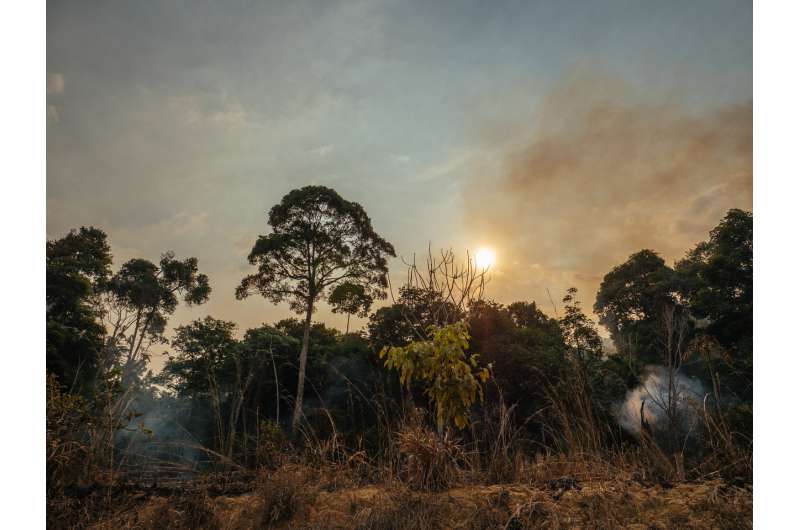Carbon emissions from Amazonian forest fires up to four times worse than feared

Carbon losses caused by El Niño forest fires of 2015 and 2016 could be up to four times greater than thought, according to a study of 6.5 million hectares of forest in Brazilian Amazonia.
New research, published in a special issue of the journal Philosophical Transactions of the Royal Society B, has revealed that the aftermath of 2015 and 2016 forest fires in the Amazon resulted in CO2 emissions three to four times greater than comparable estimates from existing global fire emissions databases.
The finding is part of a series of results published this week by Lancaster University researchers who were working in the heart of the site of one of the worst forest fires the Amazon has seen in a generation.
Researchers say uncontrolled wildfires in the understorey—or ground level—of humid tropical forests during extreme droughts are a large and poorly quantified source of CO2 emissions.
The study 'Quantifying immediate carbon emissions from El Niño-mediated wildfires in humid tropical forests' looked at a 6.5 million hectare region, of which almost 1 million hectares of primary and secondary forests burned during the 2015-2016 El Niño (an area approximately the size of half of Wales).
Although the area analyzed covers less than 0.2% of Brazilian Amazonia, these wildfires resulted in expected immediate CO2 emissions of over 30 Million tonnes, three to four times greater than comparable estimates from global fire emissions databases.
Lead author Kieran Withey of Lancaster University said : "Uncontrolled understorey wildfires in humid tropical forests during extreme droughts are a large and poorly quantified source of CO2 emissions . These u¬nderstory fires completely consumed leaf litter and fine woody debris, while partially burning coarse woody debris; resulting in high immediate CO2 emissions. This analysis covers an area of just 0.7% of Brazil, but the amount of carbon lost corresponds to 6% of the annual emissions of the whole of Brazil in 2014."
At the end of 2015, Santarém in the Brazilian state of Pará, was one of the epicenters of that year's El Niño. The region experienced a severe drought and extensive forest fires and the researchers were working right in the middle of it. Scientists from 'ECOFOR', the international research project led by Professor Jos Barlow from Lancaster University, had installed 20 study plots in Santarém, eight of which burned.
The research team quickly realized they had the opportunity to document in detail how a forest responds to fire on this scale.
Dr. Erika Berenguer of Oxford and Lancaster University, and colleagues found that following the fires, the surviving trees grew significantly more than those located in unburned forests, regardless of their history of previous human disturbance. On average trees in burned areas of forest grew 249% more than trees in forests hit by drought but not fire. Although the growth rate is good news, this large increase in growth appears to be a relatively short-term response.
Professor Jos Barlow of Lancaster University said: "Only a few trees can survive these wildfires, as Amazonian forests did not co-evolve with this threat. So even though surviving trees grow faster in burned forests, this does not compensate the large carbon loss that results from tree mortality."
Meanwhile, Camila V. J. Silva of Lancaster University led research including 31 other burned plots across the Brazilian Amazon, which showed that even 30 years after a fire, seemingly 'recovered' forests still hold 25% less carbon than nearby undisturbed primary forests.
She said: "Wildfires in humid tropical forests can significantly reduce forest biomass for decades by enhancing mortality rates of large and high wood density trees (such as Brazil Nut or Mahogany) , which store the largest amount of biomass in old growth forests. Our work has demonstrated that wildfires significantly slow down or stall the post-fire recovery of Amazonian forests.
Dr. Berenguer said: "Overall, our combined results highlight the importance of considering wildfires in Brazilian forest conservation and climate change policies. With climate models projecting a hotter and drier future for the Amazon basin, wildfires are likely to become more widespread. The continued failure to consider wildfires in public policies will lead to shorter fire-return intervals, with forests being unable to recover their carbon stocks."
More information: * Silva C.V.J., Aragao, L.E.O.C., Barlow, J. et al. (2018). Drought-induced Amazonian wildfires instigate a decadal-scale disruption of forest carbon dynamics. Philosophical Transactions Royal Society B. DOI: 10.1098/rstb.2018.0043
* Withey, K. Berenguer, E., Palmeira, A., et al. (2018). Quantifying immediate carbon emissions from El-Niño mediated wildfires in humid tropical forests. Philosophical Transactions Royal Society B. DOI: 10.1098/rstb.2017.0312
Berenguer, E. et al. (2018) Tree growth and stem carbon accumulation in human-modified Amazonian forests following drought and fire. Philosophical Transactions Royal Society B. DOI: 10.1098/rstb.2017.0308
Journal information: Philosophical Transactions of the Royal Society B
Provided by Lancaster University



















